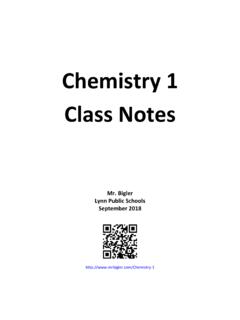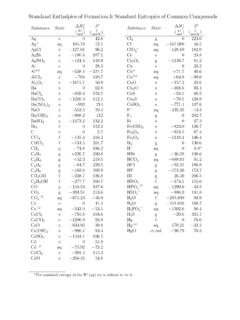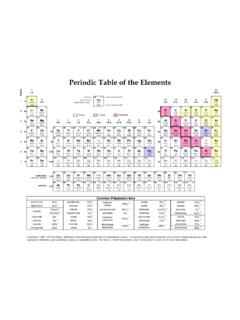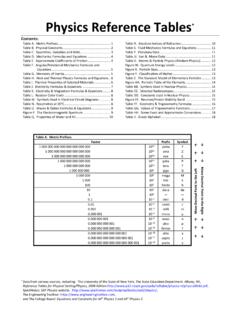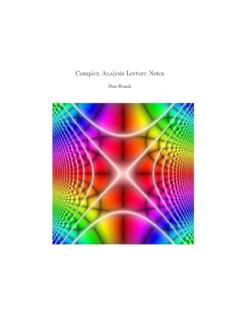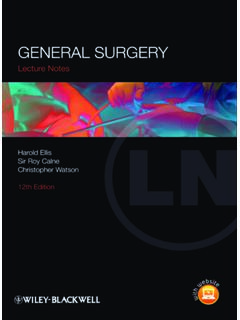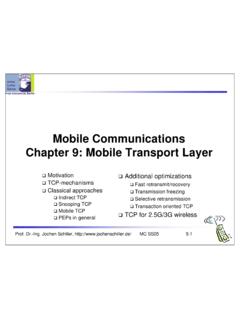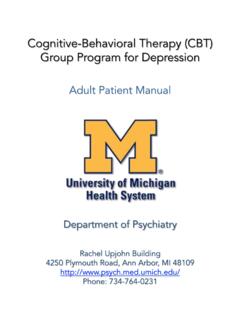Transcription of Chemistry 1 Class Notes - Mr. Bigler
1 Chemistry 1 Class Notes Mr. Bigler Lynn Public Schools September 2018 Copyright 2006 2018 Mr. Bigler . This document is licensed under a Creative Commons Attribution-NonCommercial-ShareAlike International (CC BY-NC-SA ) License. You are free to: Share copy and redistribute the material in any medium or format Adapt remix, transform, and build upon the material The licensor cannot revoke these freedoms as long as you follow the license terms. Under the following terms: Attribution You must give appropriate credit, provide a link to the license, and indicate if changes were made.
2 You may do so in any reasonable manner, but not in any way that suggests the licensor endorses you or your use. NonCommercial You may not use the material for commercial purposes. ShareAlike If you remix, transform, or build upon the material, you must distribute your contributions under the same license as the original. No additional restrictions You may not apply legal terms or technological measures that legally restrict others from doing anything the license permits. Notices: You do not have to comply with the license for elements of the material in the public domain or where your use is permitted by an applicable exception or limitation.
3 No warranties are given. The license may not give you all of the permissions necessary for your intended use. For example, other rights such as publicity, privacy, or moral rights may limit how you use the material. If you have specific questions about your desired use of this material, or if you would like to request a specific exemption to these license terms, please contact the author at ISBN-13: 978-1517557300 ISBN-10: 1517557305 Chemistry 1 Note to Students Page: 3 This is a set of Class Notes for a first-year high school Chemistry course. These Notes can be used for any honors or CP1 Chemistry course by omitting information that is specific to the higher-level course.
4 This hardcopy is provided so that you can fully participate in Class discussions without having to worry about writing everything down. While a significant amount of detail is included in these Notes , they are intended to supplement the textbook, classroom discussions, experiments and activities. These Class Notes and the textbook discussion of the same topics are intended to be complementary. In some cases, the Notes and the textbook differ in method or presentation, but the Chemistry is the same. There may be errors and/or omissions in any textbook. There are almost certainly errors and omissions in these Notes , despite my best efforts to make them clear, correct, and complete.
5 About the Homework Problems The homework problems include a mixture of easy and challenging problems. (Remember that these Notes are intended for use in both regular-level and honors-level Chemistry classes.) The process of making yourself smarter involves challenging yourself, even if you are not sure how to proceed. By spending at least 10 minutes attempting each problem, you build neural connections between what you have learned and what you are trying to do. Even if you are not able to get the answer, when we go over those problems in Class , you will reinforce the neural connections that led in the correct direction.
6 Answers to the problems are often provided so you can check your work and see if you are on the right track. Do not simply write those answers down, in order to receive credit for work you did not do. This will give you a false sense of confidence, and will actively prevent you from using the problems to make yourself smarter. You have been warned. Using These Notes As we discuss topics in Class , you will want to add your own Notes to these. If you have purchased this copy, you are encouraged to write directly in it, just as you would write in your own notebook. If this copy was issued to you by the school and you intend to return it at the end of the year, you will need to write your supplemental Notes on separate paper.
7 If you do this, be sure to write down page numbers in your Notes , to make cross-referencing easier. You should bring these Notes to Class every day, because lectures and discussions will follow these Notes , which will also be projected onto the SMART board. Chemistry 1 Note to Teachers Page: 4 These Notes , and the course they accompany, are designed to follow both the 2016 Massachusetts Curriculum Frameworks, and the 2016 Massachusetts Curriculum Frameworks, which are based on the Next Generation Science Standards (NGSS). The Notes also utilize strategies from the following popular teaching methods: Each topic includes Mastery Objectives and Success Criteria, as presented in the Studying Skillful Teaching course, from Research for Better Teaching (RBT).
8 Each topic includes Tier 2 vocabulary words and language objectives, from the Rethinking Equity and Teaching for English Language Learners (RETELL) course. Notes are organized in two-column Notes format, with a top-down web at the beginning of each unit and a page for students to summarize the unit at the end, from Keys To Literacy. The order of topics in a Chemistry course is a hotly-debated subject. These Notes and the course they accompany are organized as follows: The most controversial decision was to place gases & gas laws at the beginning of the course, right after matter.
9 The rationale is to keep the macroscopic study of matter together, and to have a topic that is rich in lab experiments and demonstrations early in the course. One downside to this approach is that moles need to be introduced in a rudimentary fashion early in the course, and re-introduced and expanded on 1 acknowledgements Page: 5 These Notes would not have been possible without the assistance of many other people. I cannot mention everyone, but I would particularly like to thank: Every student I have ever taught, for helping me learn how to teach, and how to explain and convey challenging concepts.
10 Every teacher I have worked with, for their kind words, sympathetic listening, helpful advice and suggestions, and other contributions great and small that have helped me to enjoy and become competent at the profession of teaching. Many of the department heads and principals I have worked with, for mentoring and encouraging me and allowing me to develop my own teaching style. In particular, Mark Greenman, Marilyn Hurwitz, Scott Gordon, Barbara Osterfield, Wendell Cerne, John Graceffa, Maura Walsh, Lauren Mezzetti, and Tom Strangie. The Chemistry teachers I have worked with over the years who have generously shared their time, expertise, and materials.
